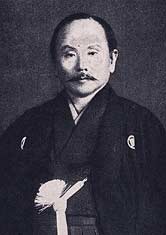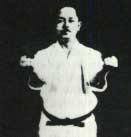Roots Of Shotokan:
Funakoshi's Original 15 Kata
Part 1- Classification & Knowledge Of Kata
by Joe Swift

Editor's Note: The first of this three part
series that examines the roots of Shotokan karate through Gichin Funakoshi's
15 original kata. The first article discusses the controversy over Funakoshi's
classification of Shorin and Shorei by body type, as well as his knowledge
of kata. The last two articles focus on in-depth discussions of the
meaning and origin of Funakoshi core kata.
Introduction
Gichin Funakoshi is probably the best known karate master of the early
20th century and is known by many as the "Father Of Japanese Karate."
It was Funakoshi who was first selected to demonstrate his Okinawan
art on mainland Japan. In Japan Funakoshi helped build the popularity
of his fledgling art and helped it gain acceptance by the all important
Japanese organization founded (and sanctioned by the government) to
preserve and promote the martial arts and ways in Japan (the Dai Nippon
Butokukai). An author of several pioneering books on karate, he was
the founder Shotokan karate from which many other styles derived.
When Funakoshi arrived in Japan in 1922, he originally taught a total
of fifteen kata, although it has been speculated that he probably knew
many more. The purpose of this article will be to introduce some of
the theories on the possible origins of these kata, provide some historical
testimony on them, and try and improve the overall understanding of
the roots of Shotokan.
Funakoshi's Kata Classification System
Funakoshi, following a traditional model of classifying karate by divided
it into two separate traditions, Shorei and Shorin.
This classification derives from early karate masters which were not
associated with their own ryu or martial traditions, but with the towns
within which they lived and practiced: Shuri, the capital and political
center; Naha, a nearby seaport and trade center, and Tomari a smaller
sea port. The early karate practiced in Shuri and to a lesser extent
Tomari combined to be known as Shorin-ryu and is associated with the
descendants and/or styles of such karate luminaries as Soken Matsumura
(Shuri), Kosaku Matsumura (Tomari) and followed by Anko Itosu and Chosin
Chibana. The karate of Naha became known as Shorei-ryu and is associated
with such karate styles of Goju-ryu and Uechi-Ryu.
It was the Shorei and Shorin classification of styles (ryu) that Funakoshi
followed. He characterized them as follows. Funakoshi said that "Shorei-ryu
is suitable for people of large build, whereas Shorin-ryu is suitable
for those of smaller frames, less physically powerful or thin, like
a willow. For basic posture, Shorei- ryu is good, but it lacks the speed
necessary for a real confrontation. Shorin-ryu is quick, but if the
practitioner is grabbed, they will be unable to move. Therefore, for
those who aspire to practice karate, it is important to pick up the
good points of each." (Funakoshi 1922, pp. 5-6)
This specific classification, i.e. dividing Shorin-ryu and Shorei-ryu
by the body types of the practitioners, can be traced as far back as
1914, when Funakoshi penned an article on karate for the Ryukyu Shinpo
newspaper, based on the lectures of his main teacher Anko Asato, and
writing under his pen name Shoto. While it is true that Funakoshi's
other main teacher Anko Itosu, had also stated that there were two "styles"
of karate, Shorin-ryu and Shorei-ryu, in his 1908 letter addressed to
the Ministry of Education and the Ministry of War, he never characterized
them as relating to body types. The famous Okinawan Bubishi also mentions
Shorinji-ryu and Shoreiji-ryu (see, for example, Mabuni, 1934), but
again, does not state the differences between the two.
 Indeed,
other prominent teachers of the day also took exception to Funakoshi's
classification. In 1930, Chojun Miyagi was quoted as saying that the
breakdown of Shorin-ryu and Shorei-ryu into kata for differing body
types, as Funakoshi did, was unfounded (Miki, et al, 1930). Miyagi also
went on to say basically the same thing in his 1934 essay Karatedo Gaisetsu
(McCarthy, 1999). At the 1936 "meeting of the masters," he
said that the only real difference between Shorin-ryu and Shorei-ryu
lay in their teaching methods (ibid.).
Indeed,
other prominent teachers of the day also took exception to Funakoshi's
classification. In 1930, Chojun Miyagi was quoted as saying that the
breakdown of Shorin-ryu and Shorei-ryu into kata for differing body
types, as Funakoshi did, was unfounded (Miki, et al, 1930). Miyagi also
went on to say basically the same thing in his 1934 essay Karatedo Gaisetsu
(McCarthy, 1999). At the 1936 "meeting of the masters," he
said that the only real difference between Shorin-ryu and Shorei-ryu
lay in their teaching methods (ibid.).
 Later,
Mabuni Kenwa and his co-author Nakasone Genwa, in their 1938 publication
"Kobo Kenpo Karatedo Nyumon," also disagreed with Funakoshi's
categorizations.
Later,
Mabuni Kenwa and his co-author Nakasone Genwa, in their 1938 publication
"Kobo Kenpo Karatedo Nyumon," also disagreed with Funakoshi's
categorizations.
The main thrust of the Mabuni/Nakasone argument is that if this is
indeed a valid classification system, then why did Funakoshi change
the classifications of certain kata, namely Wanshu (Shorei-ryu to Shorin-ryu),
Chinto (Shorei-ryu to Shorin-ryu) and Jitte (Shorei-ryu to Shorin-ryu,
than back to Shorei-ryu)?
They also argue that following Funakoshi's classification method, Chojun
Miyagi's (founder of Goju karate) brainchild Tensho would clearly belong
to the Shorei-ryu. However, as Mabuni (founder of Shito-Ryu karate)
and Nakasone (a famous Tomari/Matsumura karate-ka) state, Tensho was
based on the chapter entitled Rokkishu (showing six open hand positions
with some description of their application) in the Bubishi (a once secret
text on White Crane and Monk Fist kung fu hand copied and passed among
many early Oknawan karate masters), and it is clearly stated within
that Rokkishu belongs to the Shorin(ji)ryu (Mabuni et al, 1938).
Funakoshi's Kata Knowledge
The fifteen kata in Funakoshi's syllabus included:
However, his early books indicate that he may have had at least a passing
familiarity with several others. In his 1922 "Ryukyu Kenpo Karate,"
Funakoshi also lists an additional 16 kata (Funakoshi, 1922) including:
an additional Passai kata (listing both Dai & Sho) and Kushanku
kata (listing both Dai & Sho), Gojushiho, Chinte, Jiin, Wandau,
Rohai, Jumu, Wando, Sochin, Niseishi, Sanseiru, Suparinpei, Wankan,
Kokan, and Ushu.
It is also no less interesting that in his 1925 "Rentan Goshin
Karate Jutsu," he lists the same kata, with the addition of Sanchin
(Funakoshi, 1925).
So, we can see that Funakoshi had at least a passing familiarity with
many kata outside of his own curriculum of fifteen. This is only natural
as Funakoshi himself tells us that he had received brief instruction
from many prominent masters of that era, including Sokon "Bushi"
Matsumura, Peichin Kiyuna, Seisho Aragaki and Kanryo Higashionna (Funakoshi,
1956). Some sources even point to the famous Taite (Kojo) Kogusuku as
being Funakoshi's first instructor (Fujiwara, 1990; Iwai, 2000).
Although he does not quote his source, noted Japanese martial arts
historian Ryozo Fujiwara states that Funakoshi first learned Pechurin
kata under Taite Kogusuku, Kushanku under Anko Asato and Naifuanchi
under Anko Itosu (Fujiwara, 1990).
The next
two articles in this series will discuss each of these
kata in depth, including discussion or their possible origin and meaning.
About The Author:
Joe Swift, native of New York State (USA), has lived in Japan since
1994. He works as a translator/interpreter, and previously served
as an assistant instructor at the Mushinkan Okinawa Karate Kobudo
Dojo in Kanazawa. Swift now resides in Tokyo and will be opening a
a branch of the Mushinkan Dojo (Okinawa Shoreiryu) in that city. A
well know karate historian and researcher, Swift has published articles
in the Dragon Times and other leading martial arts journals and on
a variety of martial arts sites around the world. He is a Contributing
Editor for FightingArts.com.